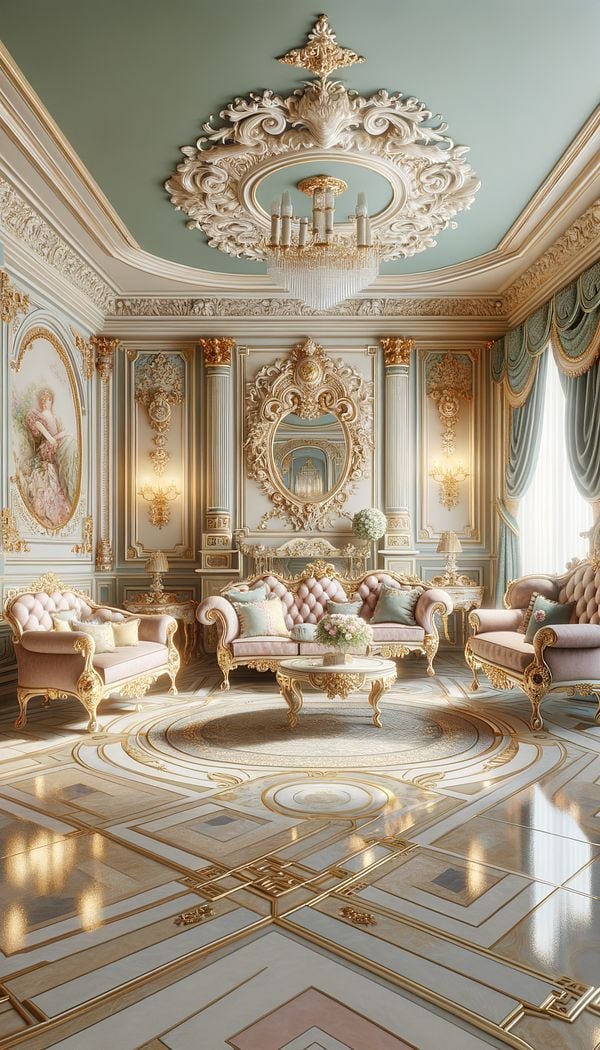What is Rococo?
Rococo is an elaborately ornamental late baroque style of decoration prevalent in 18th-century continental Europe.
Description
Rococo is a distinctive style that originated in early 18th-century France as a reaction against the grandeur and strict regulations of the Baroque, especially of the Palace of Versailles. It is characterized by its lightness, elegance, and an exuberant use of curving, natural forms in ornamentation. The Rococo style is often considered the more decorative period of the Baroque era, focusing on asymmetry, pastel colors, and light, fluid movements.
The term “Rococo” derives from the French word 'rocaille' (meaning "rock and shell garden ornamentation") and 'coquilles' (meaning "shells"), indicating the extensive use of these motifs in Rococo interiors. The style extended to painting, sculpture, and the decorative arts—such as furniture, tapestry, metalwork, and ceramics—infused with themes of love, nature, and frivolity. It was a style meant to appeal to the senses, designed to be visually pleasing and romantic.
Rococo rooms are typically light-filled, intimate spaces with ornamental mirrors, fluid lines, and delicate color and patterns. Walls are often decorated with decorative panels painted with pastoral scenes or adorned with gold gilded elements. Furniture in the Rococo style features curves, intricate carvings, and is frequently upholstered with luxurious fabrics.
The style began to decline in the late 18th century as tastes shifted towards the more sober and morally strict dictates of Neoclassicism. However, Rococo still influences modern interior design, especially in spaces seeking to convey a sense of elegance, romance, and whimsy.
Usage
In interior design, the Rococo style is applied through the use of ornamental mirrors, light-colored wall and ceiling treatments, and furniture that features curves and intricate carvings. Fabrics are luxurious, featuring textiles and upholstery with complex patterns and pastel tones. Decorative panels and gold gilding are often used to add a touch of opulence and visual richness.
FAQs
-
How is Rococo different from Baroque?
Rococo is seen as a more decorative and lighthearted evolution of the Baroque style, emphasizing asymmetry, pastel colors, and fluid, natural forms, in contrast to the grandeur and symmetry of Baroque.
-
What are common motifs in Rococo design?
Common motifs include natural elements like shells and rocks ('rocaille'), flowers, and scenes depicting love and leisure, all designed to be visually pleasing and romantic.
-
Can Rococo style be used in modern interior design?
Yes, elements of Rococo can be integrated into modern interior design to add a sense of elegance, frivolity, and romance, especially in more intimate or personal spaces.
Practical Application
To incorporate Rococo elements into a modern interior, focus on using pastel colors, ornate decorative items, and curvilinear furniture. Integrate decorative mirrors and light-filled spaces to achieve a sense of Rococo's trademark elegance and whimsy. For a subtle approach, choose one or two Rococo-inspired pieces as accents in a contemporary setting.
-
Design Styles478 articles
-
Historical Periods & Movements150 articles
-
Decorating Principles & Elements330 articles
-
Wall & Ceiling Treatments35 articles
-
Textiles & Upholstery252 articles
-
Built-inBuilt-in refers to any feature or piece of furniture that is permanently integrated into a room's structure.
-
Asian StyleAsian Style refers to the interior design practice that incorporates elements inspired by the countries and cultures of Asia.
-
Louis XVILouis XVI refers to a French design style that emerged during the reign of King Louis XVI.
-
PercalePercale refers to a closely woven, plain-weave fabric known for its crisp, smooth texture.
-
Drop Lid DeskA drop lid desk is a type of desk featuring a hinged writing surface or lid that can be opened or closed.
